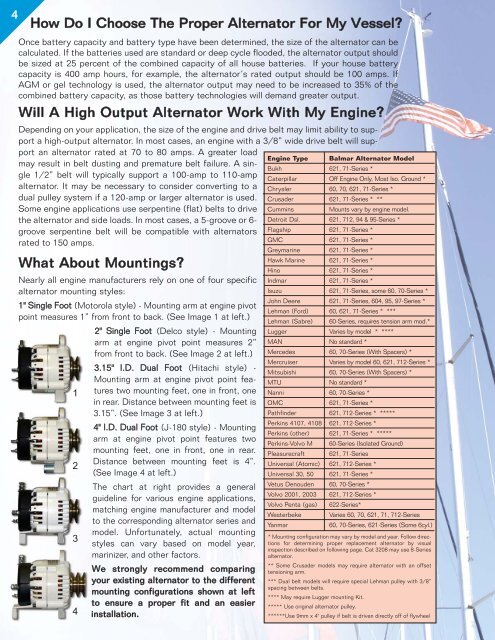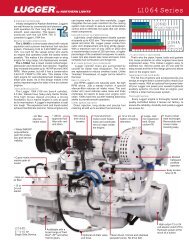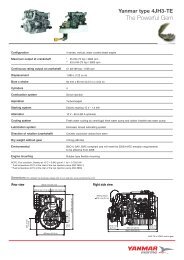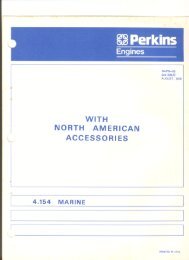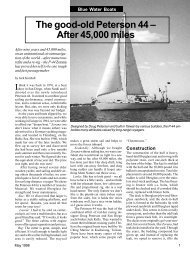Balmar - Boat Electric
Balmar - Boat Electric
Balmar - Boat Electric
Create successful ePaper yourself
Turn your PDF publications into a flip-book with our unique Google optimized e-Paper software.
4<br />
How Do I Choose The Proper Alternator For My Vessel?<br />
Once battery capacity and battery type have been determined, the size of the alternator can be<br />
calculated. If the batteries used are standard or deep cycle flooded, the alternator output should<br />
be sized at 25 percent of the combined capacity of all house batteries. If your house battery<br />
capacity is 400 amp hours, for example, the alternator’s rated output should be 100 amps. If<br />
AGM or gel technology is used, the alternator output may need to be increased to 35% of the<br />
combined battery capacity, as those battery technologies will demand greater output.<br />
Will A High Output Alternator Work With My Engine?<br />
Depending on your application, the size of the engine and drive belt may limit ability to support<br />
a high-output alternator. In most cases, an engine with a 3/8” wide drive belt will support<br />
an alternator rated at 70 to 80 amps. A greater load<br />
may result in belt dusting and premature belt failure. A single<br />
1/2” belt will typically support a 100-amp to 110-amp<br />
alternator. It may be necessary to consider converting to a<br />
dual pulley system if a 120-amp or larger alternator is used.<br />
Some engine applications use serpentine (flat) belts to drive<br />
the alternator and side loads. In most cases, a 5-groove or 6-<br />
groove serpentine belt will be compatible with alternators<br />
rated to 150 amps.<br />
What About Mountings?<br />
Nearly all engine manufacturers rely on one of four specific<br />
alternator mounting styles:<br />
1" Single Foot (Motorola style) - Mounting arm at engine pivot<br />
point measures 1” from front to back. (See Image 1 at left.)<br />
1<br />
2<br />
3<br />
4<br />
2" Single Foot (Delco style) - Mounting<br />
arm at engine pivot point measures 2”<br />
from front to back. (See Image 2 at left.)<br />
3.15" I.D. Dual Foot (Hitachi style) -<br />
Mounting arm at engine pivot point features<br />
two mounting feet, one in front, one<br />
in rear. Distance between mounting feet is<br />
3.15”. (See Image 3 at left.)<br />
4" I.D. Dual Foot (J-180 style) - Mounting<br />
arm at engine pivot point features two<br />
mounting feet, one in front, one in rear.<br />
Distance between mounting feet is 4”.<br />
(See Image 4 at left.)<br />
The chart at right provides a general<br />
guideline for various engine applications,<br />
matching engine manufacturer and model<br />
to the corresponding alternator series and<br />
model. Unfortunately, actual mounting<br />
styles can vary based on model year,<br />
marinizer, and other factors.<br />
We strongly recommend comparing<br />
your existing alternator to the different<br />
mounting configurations shown at left<br />
to ensure a proper fit and an easier<br />
installation.<br />
Engine Type<br />
Bukh<br />
Caterpillar<br />
Chrysler<br />
Crusader<br />
Cummins<br />
Detroit Dsl.<br />
Flagship<br />
GMC<br />
Greymarine<br />
Hawk Marine<br />
Hino<br />
Indmar<br />
Isuzu<br />
John Deere<br />
Lehman (Ford)<br />
Lehman (Sabre)<br />
Lugger<br />
MAN<br />
Mercedes<br />
Mercruiser<br />
Mitsubishi<br />
MTU<br />
Nanni<br />
OMC<br />
Pathfinder<br />
Perkins 4107, 4108<br />
Perkins (other)<br />
Perkins-Volvo M<br />
Pleasurecraft<br />
Universal (Atomic)<br />
Universal 30, 50<br />
Vetus Denouden<br />
Volvo 2001, 2003<br />
Volvo Penta (gas)<br />
Westerbeke<br />
Yanmar<br />
<strong>Balmar</strong> Alternator Model<br />
621, 71-Series *<br />
Off Engine Only, Most Iso. Ground *<br />
60, 70, 621, 71-Series *<br />
621, 71-Series * **<br />
Mounts vary by engine model.<br />
621, 712, 94 & 95-Series *<br />
621, 71-Series *<br />
621, 71-Series *<br />
621, 71-Series *<br />
621, 71-Series *<br />
621, 71-Series *<br />
621, 71-Series *<br />
621, 71-Series, some 60, 70-Series *<br />
621, 71-Series, 604, 95, 97-Series *<br />
60, 621, 71-Series * ***<br />
60-Series, requires tension arm mod.*<br />
Varies by model * ****<br />
No standard *<br />
60, 70-Series (With Spacers) *<br />
Varies by model 60, 621, 712-Series *<br />
60, 70-Series (With Spacers) *<br />
No standard *<br />
60, 70-Series *<br />
621, 71-Series *<br />
621, 712-Series * *****<br />
621, 712-Series *<br />
621, 71-Series * *****<br />
60-Series (Isolated Ground)<br />
621, 71-Series<br />
621, 712-Series *<br />
621, 71-Series *<br />
60, 70-Series *<br />
621, 712-Series *<br />
622-Series*<br />
Varies 60, 70, 621, 71, 712-Series<br />
60, 70-Series, 621-Series (Some 6cyl.)<br />
* Mounting configuration may vary by model and year. Follow directions<br />
for determining proper replacement alternator by visual<br />
inspection described on following page. Cat 3208 may use 8-Series<br />
alternator.<br />
** Some Crusader models may require alternator with an offset<br />
tensioning arm.<br />
*** Dual belt models will require special Lehman pulley with 3/8”<br />
spacing between belts.<br />
**** May require Lugger mounting Kit.<br />
***** Use original alternator pulley.<br />
******Use 9mm x 4" pulley if belt is driven directly off of flywheel


